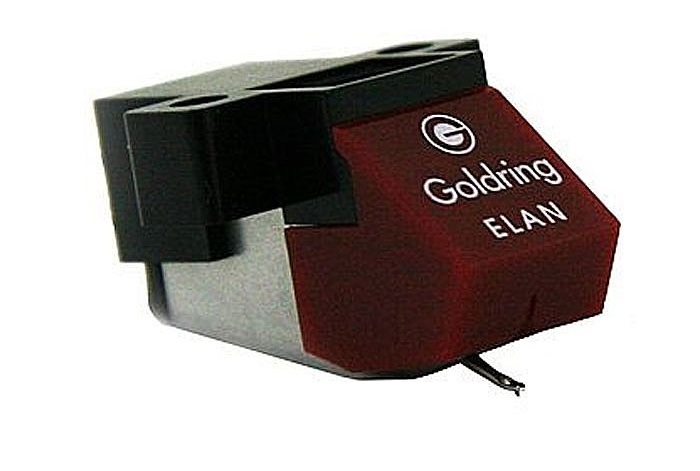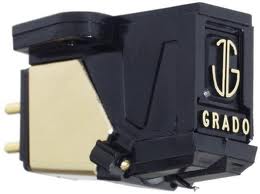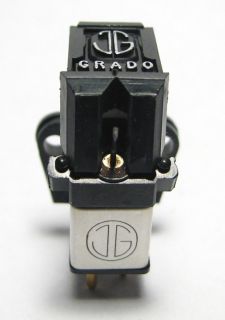When I took the TD-165 away from a friend of mine who had thrown it into a closet, as first thing I bought a new moving magnet (MM) cartridge. I asked advice in a HiFi shop and they sold me a Golding Elan for 80  thousand Lire, dismissing my Thorens with a “that’s all a deck like that deserves!”. Later I swapped the thin phono cables with simple low capacity, coaxial microphone cables; I also scrapped the original power chord.
thousand Lire, dismissing my Thorens with a “that’s all a deck like that deserves!”. Later I swapped the thin phono cables with simple low capacity, coaxial microphone cables; I also scrapped the original power chord.
 A few years later I found out on the Internet forums and websites that that “deck” would be worth much more. In 2005, after advice from TNT-Audio’s ever helpful Lucio Cadeddu, I purchased a Grado Prestige Gold cartridge. In 2010 I had to renew the stylus with a Gold1 replacement and in 2015 I upgraded to the Grado 8MZ Signature stylus – an incredible quality advancement: some claim it is comparable to the sound of top Grado carts, for just 130 euros! Unfortunately, I dropped the stylus while attempting to move it on another cartridge and the suspension damage caused an evident drop of the signal level.
A few years later I found out on the Internet forums and websites that that “deck” would be worth much more. In 2005, after advice from TNT-Audio’s ever helpful Lucio Cadeddu, I purchased a Grado Prestige Gold cartridge. In 2010 I had to renew the stylus with a Gold1 replacement and in 2015 I upgraded to the Grado 8MZ Signature stylus – an incredible quality advancement: some claim it is comparable to the sound of top Grado carts, for just 130 euros! Unfortunately, I dropped the stylus while attempting to move it on another cartridge and the suspension damage caused an evident drop of the signal level.
 In 2016, I purchased a used 1986 Grado Signature 8MX body, which I mounted on a spare TP60 headshell. I have been using it with the Gold1 stylus with excellent results on my new TD-160. I equipped the turntable with Van Damme Silver Plated OFC cables and gold plated Neutrik hooked to an excellent Lehman Black Cube phono stage.
In 2016, I purchased a used 1986 Grado Signature 8MX body, which I mounted on a spare TP60 headshell. I have been using it with the Gold1 stylus with excellent results on my new TD-160. I equipped the turntable with Van Damme Silver Plated OFC cables and gold plated Neutrik hooked to an excellent Lehman Black Cube phono stage.
Later I found a Shure Me97HE cartridge someone was about to throw away and I bought a cheap used Nagaoka ED stylus just to see if it worked. I was surprised by how good it sounded but later a friend form the US made me an incredible price for an Audiotechnica AT95HE that completely blew me away with its sound (note that I’m running the Shure with and elliptical stylus rather than the hyperelliptcal one it is supposed to mount). But the most interesting thing about this cartridge swap is that on the suspended floor of my new home the Shure was bouncing on the record while we walked on the floor; the AT does not move even if we jump. It is a matter of resonance frequency. I had to thoroughly align the Shure M97 in order to minimize bouncing.

Thorens turntables came stock with a rather heavy tonearm: the TP 11 on the TD 165 and the TP 16 on the TD 160 both have a effective mass of 16.5 g, a rather heavy weight. This mass affects the resonance frequency of the tonearm/cartridge/stylus system as it vibrates while reading the record’s groove. The effective mass of a tonearm is the mass value that balances the counterweight on the other side of the pivot, when the counterweight is at a distance from the pivot that keeps the tonearm horizontal (VTF=0).
The effective mass of a tonearm depends on the moment of inertia, the physical quantity describing the resistance (inertia) to rotation. The moment of inertia is equal to the mass times the square of its distance from the center of rotation (try to push open a heavy door near the hinges and you see what I mean: the farther we push away from the hinges, the easier it is to open/rotate the door). The effective mass Me of a tonearm of effective length L (the distance from the pivot to the stylus tip) gives a moment of inertia equal to MeL2.
The tonearm is a lever balanced around the pivot. On one side, the biggest mass is the counterweight m at a distance r from the pivot. Therefore the moment of inertia is mr2. On the other side of the pivot we should also consider the tonearm wand’s mass Z and the distance to the pivot, which is the effective length L. Here the moment of inertia of a standard rod of mass Z is calculated as ZL2/3. Equating the two moments of inertia and then solving for Me we have:
Me = mr2/L2 + Z/3
We can see the effective mass depends on the position (r2) of the counterweight mass m and the amount of mass at the cartridge’s side (Z): if we increase the counterweight mass we have to move it closer to the pivot, therefore reducing r, which varies with the square. Possibly, we could reduce our TP11/16 effective mass by adding some mass to the counterweight.
The resonance frequency can be calculated by taking into account the tonearm’s effective mass (Me), the cartridge’s weight (Mc) and its compliance (C), which is a measure of its resistance to the imposed weight; the weight of mounting screws, shims, etc. (Mf) is also to be input in the following formula:
![]() The formula yields the resonance frequency in hertz; it should stay within the 8 – 15 range (8 – 12 according to some), away from typical rotating platter resonance (around 4 hz) and from the bottom end of the audible range (20 hz). The ideal value is around 10 hz. My current system includes the TP-16 MKI with a 16.5 g effective mass; when I was running my Grado Gold, I saved nearly half gram by removing the Metal logo plate and another plastic piece from the shell. The Grado Gold weighs 5.5 g (although declared at 6 g) and has a 20×10^6 cm/dyne compliance. Taking into account about 0.7 g of screws and shims, I obtained a 7.5 hz resonance frequency, unfortunately out of the suggested range. Nevertheless, I did not experience any problems. After I purchased the HiFi News test record HFN 003, the resonance frequency check track gave a result of 13 Hz. Far better! Some believe the HiFi news record has the wrong frequencies; that would mean my result is actually 11 Hz – perfect! The more so since the infamous torture track n. 9, where the best cartridges are said to be spat out of the record, has been tracked with almost no hassle! I’m really satisfied. Some says that the bearings of my tonearm must be in really good conditions in order to achieve this performance! Even the 8MX cart, mounted on an unmodified TP60 Thorens headshell has also performed well on the test record. The resonance frequency has been tested at around 9-10 Hz, therefore it should be around 8 Hz, actually, near the lower limit.
The formula yields the resonance frequency in hertz; it should stay within the 8 – 15 range (8 – 12 according to some), away from typical rotating platter resonance (around 4 hz) and from the bottom end of the audible range (20 hz). The ideal value is around 10 hz. My current system includes the TP-16 MKI with a 16.5 g effective mass; when I was running my Grado Gold, I saved nearly half gram by removing the Metal logo plate and another plastic piece from the shell. The Grado Gold weighs 5.5 g (although declared at 6 g) and has a 20×10^6 cm/dyne compliance. Taking into account about 0.7 g of screws and shims, I obtained a 7.5 hz resonance frequency, unfortunately out of the suggested range. Nevertheless, I did not experience any problems. After I purchased the HiFi News test record HFN 003, the resonance frequency check track gave a result of 13 Hz. Far better! Some believe the HiFi news record has the wrong frequencies; that would mean my result is actually 11 Hz – perfect! The more so since the infamous torture track n. 9, where the best cartridges are said to be spat out of the record, has been tracked with almost no hassle! I’m really satisfied. Some says that the bearings of my tonearm must be in really good conditions in order to achieve this performance! Even the 8MX cart, mounted on an unmodified TP60 Thorens headshell has also performed well on the test record. The resonance frequency has been tested at around 9-10 Hz, therefore it should be around 8 Hz, actually, near the lower limit.
 According to math, I should look for a lower compliance cartridge. It appears the formula is not really reliable, but there are people who believe the Grado styli’s compliance is far lower than declared: calculating C with a 11 Hz resonance frequency, it would give out 9.5 versus the 20 x106 cm/dyne declared compliance! I could mount a lighter arm like the 6.5 g SME 3009 Improved (or somehow lighten up mine), but it seems, against popular beliefs, that Grado carts get along very well on Thorens arms. Eventually, my good old Thorens could deserve a better tonearm one day but it will have to battle against this flattering performance of the TP-16 MKI…
According to math, I should look for a lower compliance cartridge. It appears the formula is not really reliable, but there are people who believe the Grado styli’s compliance is far lower than declared: calculating C with a 11 Hz resonance frequency, it would give out 9.5 versus the 20 x106 cm/dyne declared compliance! I could mount a lighter arm like the 6.5 g SME 3009 Improved (or somehow lighten up mine), but it seems, against popular beliefs, that Grado carts get along very well on Thorens arms. Eventually, my good old Thorens could deserve a better tonearm one day but it will have to battle against this flattering performance of the TP-16 MKI…